We had an incredible opening night, of around 70 attendants – a full house at Inspace Gallery, Edinburgh. We had introductory talks from Gintarė Bagačionkaitė (Fusion) and Jane Wright (SIDB). These were followed by Dr Tom Pratt (SIDB Group Leader and Fusion member) who introduced the ‘My life’ project, where art pieces have been created by the families who work with the Patrick Wild Centre, and art is inspired by life with a genetic condition.
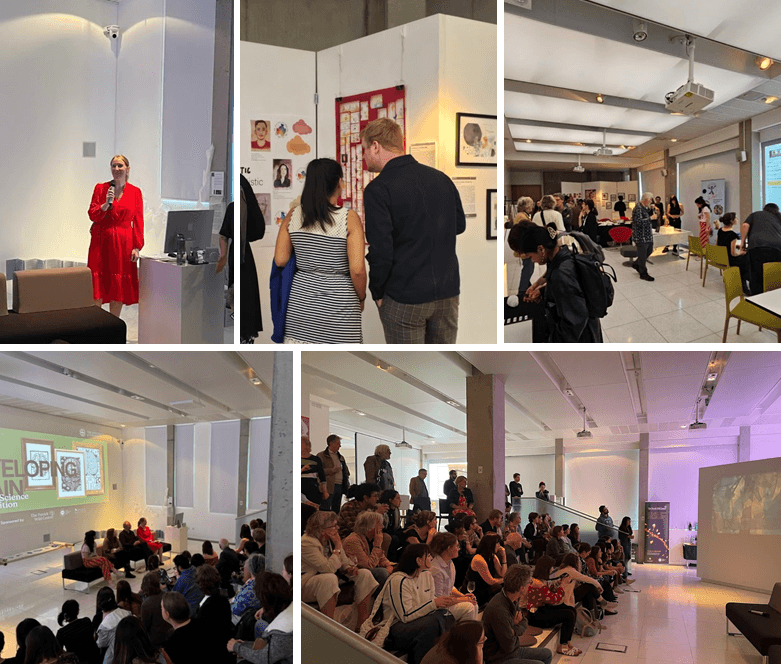

Jess Lonsdale (3rd year Biomedical sciences student at the University of Edinburgh) discussed her project ‘Building bridges in the autism community through art’. This project is, according to Jess, important to her because during her time in autism advocacy, many of the clashes she saw between individuals come from what is referred to as the ‘Double Empathy Problem’ in which neurotypical individuals and those on the autism spectrum often struggle to understand each other’s perspectives. The goal of her project is to use art to improve people’s understanding of each other’s perspectives and thus create more cooperation within the community.
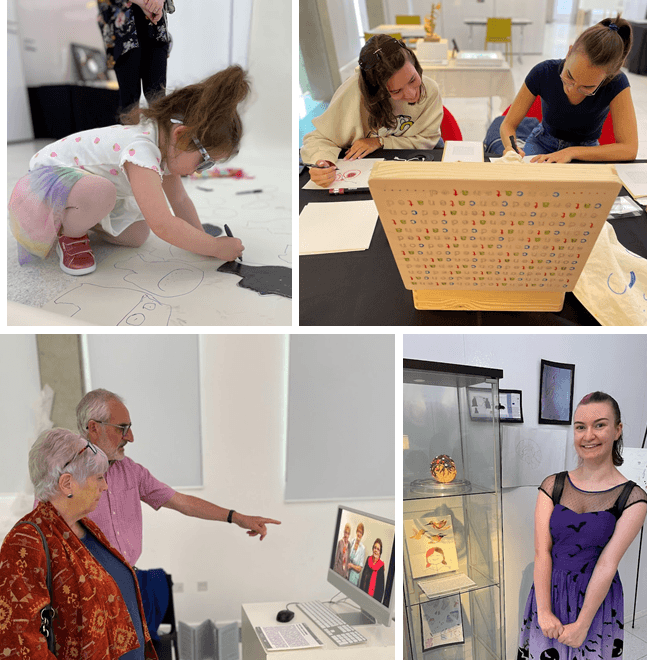
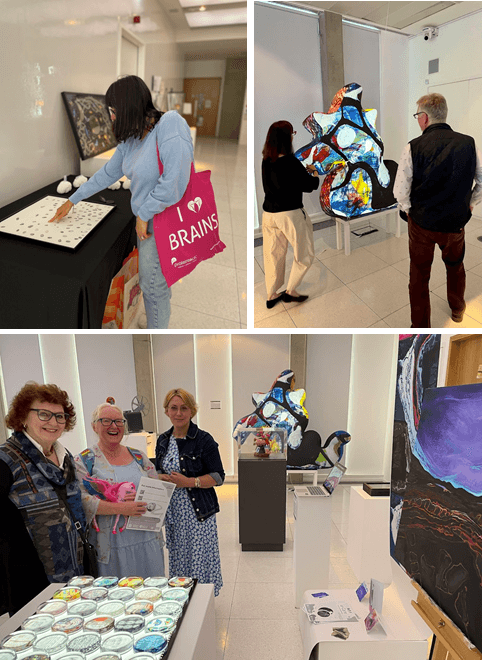
Emily Beaney (artist, filmmaker and PhD researcher at Edinburgh College of Art), discussed her project ‘Doctors and Doner Kebabs’. Her artwork celebrates individual and collective identities, and was made in collaboration with the Epilepsy Scotland Youth Group. Emily worked in a series of creative workshops, where they explored the ways in which our personalities, preferences, experiences and epilepsies come together and diverge. Emily ended her talk by showing the first live screening of her short film.
“For me, it has been very interesting to work with a medical research team from the University of Edinburgh who are working with cutting-edge laser technology to develop advances in brain surgery ablation”, says one of the artists, Jenny Bruce. Jenny’s work was later featured in the media (read more on the John O’Groat Journal Website).
It was fantastic to see cross-disciplinary collaboration and community outreach come together. The exhibition ran for a further two days (30-31st August) at Inspace Gallery, Edinburgh.
Below are the artists and scientists that exhibited.
This event was sponsored by PWC, SIDB and CDBS.
Jenny Bruce, Asta Valanciute, Tatiana Malikova
OSCILLATING BRAIN in art and science

Using histology slides of stained tissue as source material and incorporating digital techniques, this series of artworks has been created to illustrate the investigation of ablation of the brain.
UVC laser light can be used for precise ablation of tumours, which is important in neurosurgery where tumours can grow close to critical blood vessels or nerves. These artworks represent the investigations made through repetitive tests to find the laser. parameters that provide the best ablation quality. Histology and staining help to assess the depth of the ablation and confirm that the laser causes no thermal damage. to the tissue that surrounds the cut.
To my artistic eye, many histology slides can appear as landscapes with valleys and hills on the horizon. and therefore, by repeating or distorting the size of a form undulation is created. This movement can also suggest an object in continuous. flow like lava, the sea or cloud formations and demonstrate the similarities in pattern. and interconnections within the micro to the macro.
Janet Philp, Ruth Pollitt, Malcolm MacCallum
21 Days
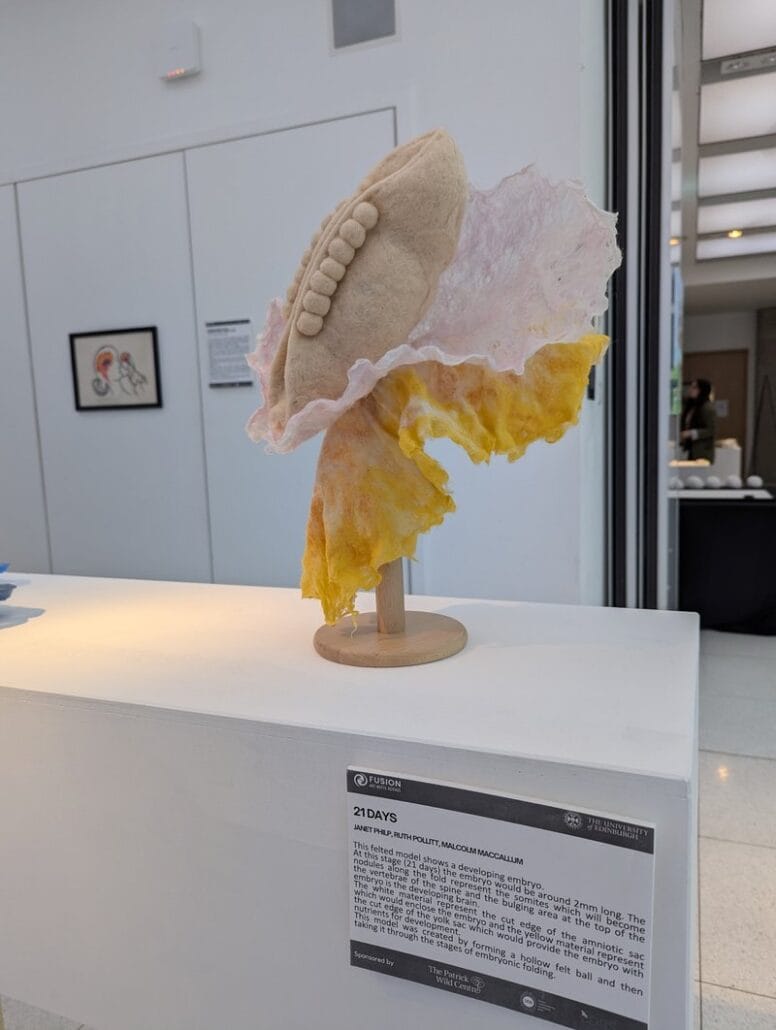
This felted model shows a developing embryo. At this stage (21 days) the embryo would be around 2mm long. The nodules along the fold represent the somites which will become the vertebrae of the spine and the bulging area at the top of the embryo is the developing brain.
The white material represent the cut edge of the amniotic sac which would enclose the embryo and the yellow material represent the cut edge of the yolk sac which would provide the embryo with nutrients for development.
This model was created by forming a hollow felt ball and then taking it through the stages of embryonic folding.
Zuzanna Baran, Kelly Zou
The maze of the familial mind
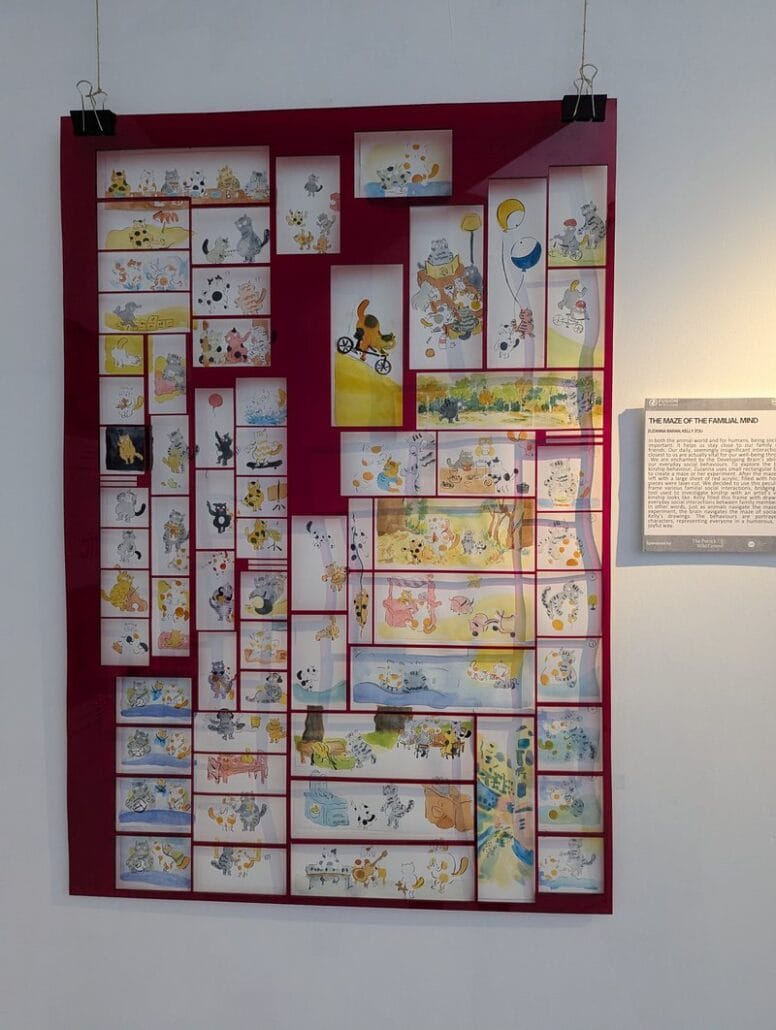
In both the animal world and for humans, being social is incredibly important. It helps us stay close to our family members and friends. Our daily, seemingly insignificant interactions with those closest to us are actually vital for our well-being throughout life.
We are enchanted by the Developing Brain’s ability to support our everyday social behaviours. To explore the brain’s role in kinship behaviour, Zuzanna uses small rectangular building pieces to create a maze or her experiment. After the maze is built, she’s left with a large sheet of red acrylic, filled with holes where the pieces were laser-cut. We decided to use this peculiar “frame” to frame various familial social interactions, bridging the scientific tool used to investigate kinship with an artist’s vision of what kinship looks like. Kelly filled this frame with drawings depicting everyday social interactions between family members and friends. In other words, just as animals navigate the maze in Zuzanna’s experiment, the brain navigates the maze of social situations in Kelly’s drawings. The behaviours are portrayed using cat characters, representing everyone in a humorous, inclusive, and joyful way
Chris Sibley, Gemma Stroyan
99 neurodevelopmental balloons

Children with neurodevelopmental conditions are unique both in their nature and in their genetics. In this vibrant and playful artwork we aim to capture this widespread diversity via the portrayal of many happy children each holding balloons that spell out the gene name underlying their unique conditions.
Barbora Skarabela, Malgorzata Bugaj
Watching your brain

Watching your Brain highlights two sides of science that help us understand how the brain changes across the life course. On one side, it represents the abstract data leading to important scientific discoveries. On the other side, it showcases the participants who provide the data and without whose dedication and commitment it would be impossible to uncover secrets of the developing brain. The installation reflects these two sides with two screens facing each other: one screen with anonymous abstract brain images based on the participants’ data, and another screen with photos of the participants who made the study possible. Quotes and other personal contributions from the study participants and over 100 titles of scientific papers on the ageing brain printed on paper create a pathway that allows us to watch the brain.
Lothian Birth Cohorts are a research group based in Psychology at the University of Edinburgh. The aim of the group is to understand how our brain and thinking skills change throughout life, and why some people’s brains age better than other’s. At the core of the research are two longitudinal studies of older adults: the Lothian Birth Cohort 1921 (LBC1921) study, established in 1999, and the Lothian Birth Cohort 1936 (LBC1936) study, established in 2004. The studies have generated a wealth of data, leading to over 600 peer-reviewed publications to date.
Barbora Skarabela, Joan Smith
Shedding Light on the Brain

In 2019, glass paperweights were created as gifts to celebrate the twentieth anniversary of the Lothian Birth Cohorts. Most were given away, but those that remain have been used in the creation of this artwork that references the LBC archives and celebrates this important study.
Lothian Birth Cohorts is a research group at the University of Edinburgh that examines how our brains and thinking skills change throughout life.
This artwork brings to life the unique story of Lothian Birth Cohorts, taking us on a journey through history when thousands of 11-year-old children took a special test of thinking skills in 1932 and 1947. The artwork features images from the study of the participants – from childhood to older years, historical records, cognitive tests and other data as well as striking images of the changing brain.
Jess Lonsdale, Tom Pratt
Building Bridges in the Autism Community Through Art
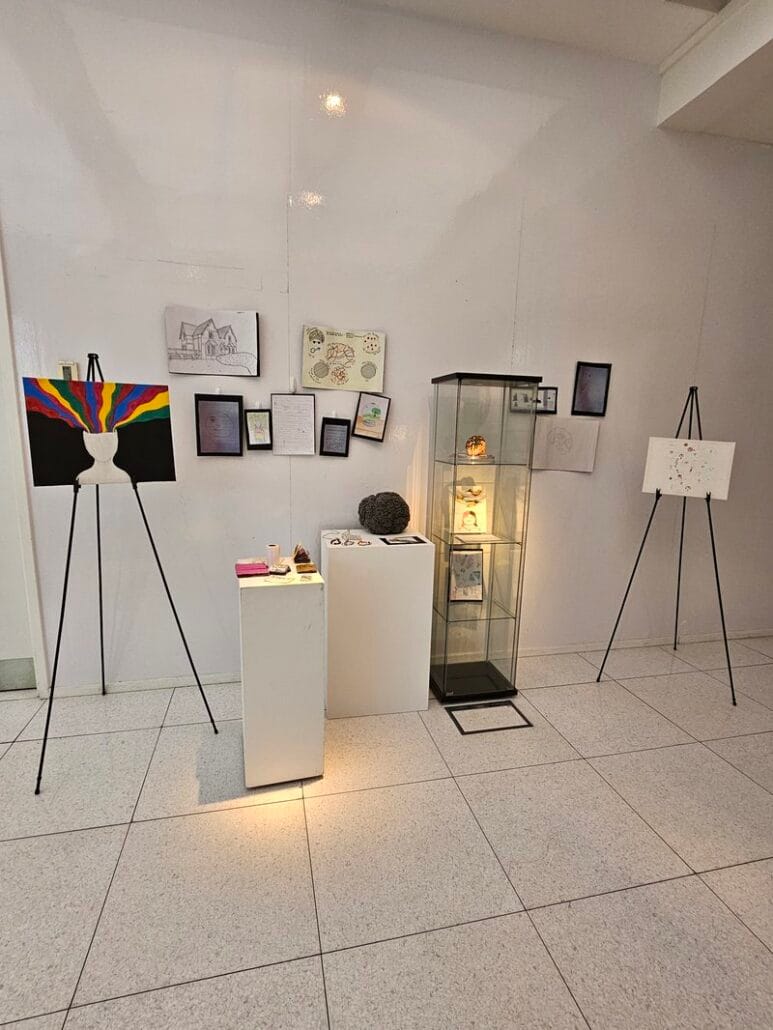
In my time in advocacy, a lot of the difficulties I saw people face came from a lack of understanding about what autism is. Often, autistic people are perceived as being in our own world, our behaviours not making much sense to outsiders and thus being viewed as negative. In my time as a hobbyist writer, I’ve come to realise that art can communicate far more fantastical things than the way a felt-tip pen can lay metaphorical ice in my bone marrow or the feeling of buzzing elation that bursts out in claps, snickers and delighted rocking when reading a comic. This inspired me to organise this project, in which autistic people, people with autistic family, people who professionally work with autistic people and those who are some combination of the three have made art about what autism means to them. I hope that these pieces make you think about all the different ways people experience autism.
Joan Smith, Tom Pratt
Concatenated
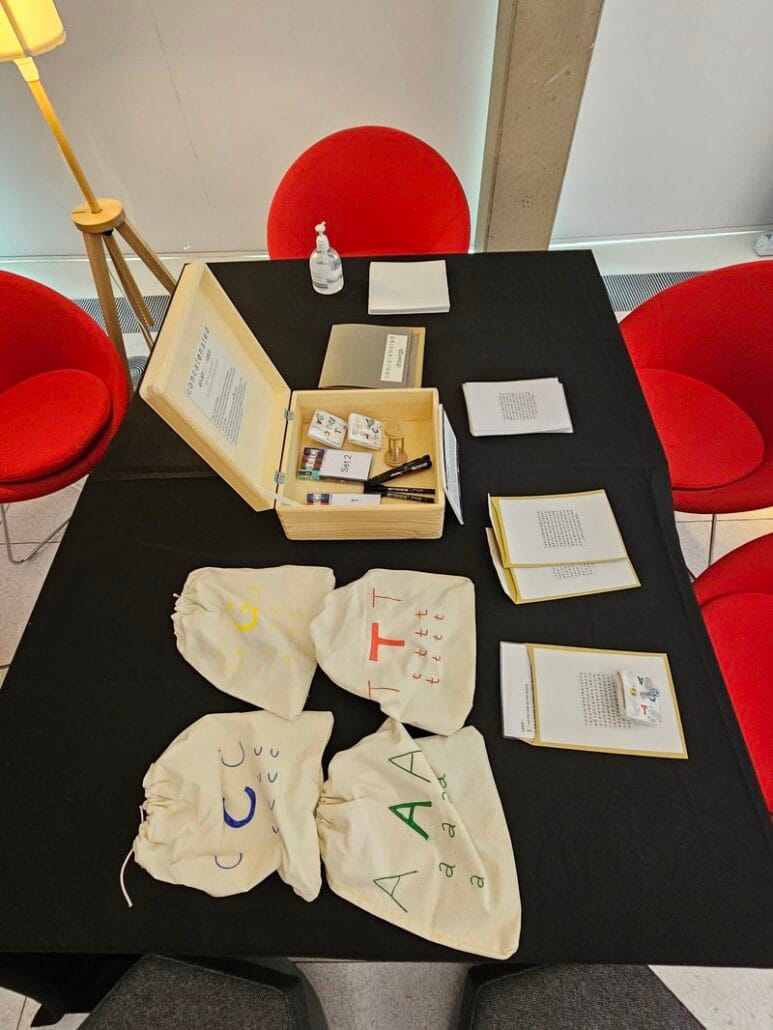
Play the game, have fun, and ponder. ‘Concatenated’ is a generative art game drawing on principles from genetics, systems art, and changes to how our minds perceive and represent things as we grow up. Players follow a series of instructions ‘genes’ each with variations ‘alleles’ selected by chance to draw an object with each drawing resulting from a unique permutation. Drawings are assembled in celebration of our diversely developing brains.
Lucy Doyle, Kelly Zou
The Journey of Neural Exploration
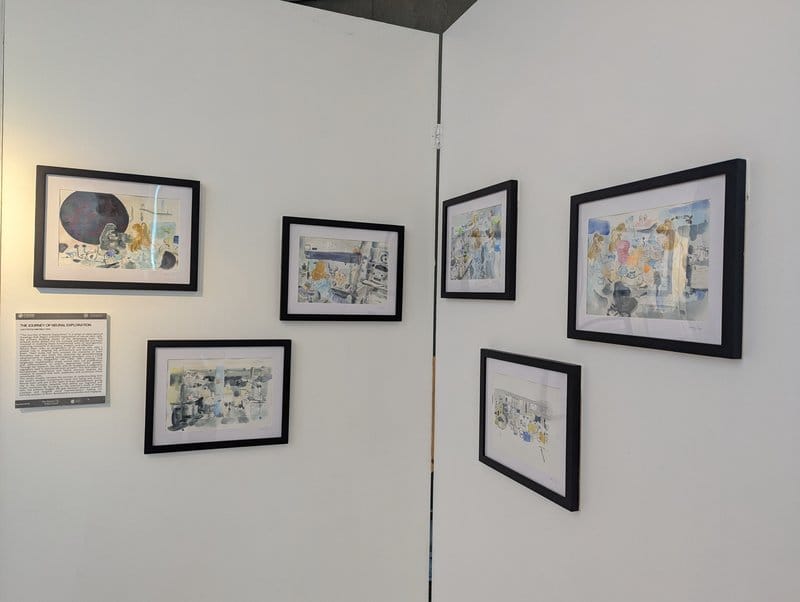
“The Journey of Neural Exploration” is a series of observational drawings that depict scientific exploration of neural stem cells, the primary building blocks of the developing brain. This artwork series delves into the intricate and delicate processes involved in studying these fundamental units of neurogenesis, capturing moments of discovery, analysis, and reflection.
Neural stem cells, as progenitors of all neural cells, play a pivotal role in shaping the architecture and function of the brain. Their study not only unravels the mysteries of brain formation but also holds the potential for groundbreaking advancements in treating neurological disorders. Lucy is a PhD student in the Illingworth Lab (CRM, IRR) studying how epigenetic modifications shape neural stem cell proliferation and differentiation to ensure appropriate brain growth. Through her research, she asks: why do mutations in epigenetic regulators lead to disordered brain growth? This dual aspect of foundational importance and future promise inspired the creation of artwork that both celebrates and scrutinizes these remarkable cells.
This series visually narrates the journey of understanding how the brain’s earliest components come into being and evolve. Neural stem cells are at the heart of brain development, giving rise to the complex networks that define our cognitive and motor functions. By focusing on the scientist’s study of these cells, the artwork bridges the gap between abstract scientific concepts and tangible visual representation, making the intricate process of brain development accessible and engaging.
Shayna Seenayah, Lusi Zhao
Brain in Bloom
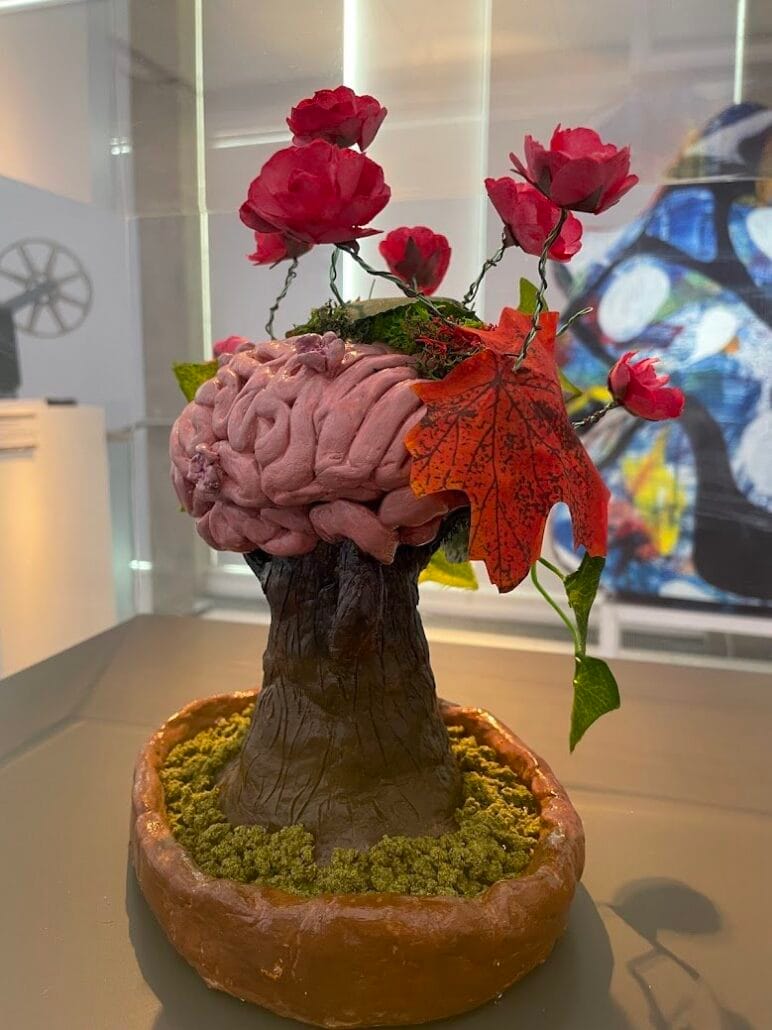
Nature is an ever-evolving entity, growing, flourishing and blooming. Much like trees, the brain develops and blossoms with time. The development of the brain is governed by many processes, including the generation of specific neurons. We have worked with “mini-brains” in the lab, observing their growth and levels of excitatory and inhibitory neurons, which are two major neuronal classes. We specifically looked at an autism-implicated mutation and how that impacts brain development. To encapsulate our laboratory work and the beautiful symmetry the brain has with trees, we moulded air-drying clay into a cherry blossom bonsai with a brain-like structure as the leafy bulk of the tree. On one side, we displayed green and red foliage to represent the excitatory (green) and inhibitory (red) neurons in our “mini-brains”, that we analysed in microscopy. Although nothing to do with our laboratory work or with the developing brain, we also added a squirrel. Can you spot her?
Stefania Brown, Lucja Kostrzewa
Artistic autistic. The Beautiful face of autism: all the shades of the spectrum and how the autistic brain develops
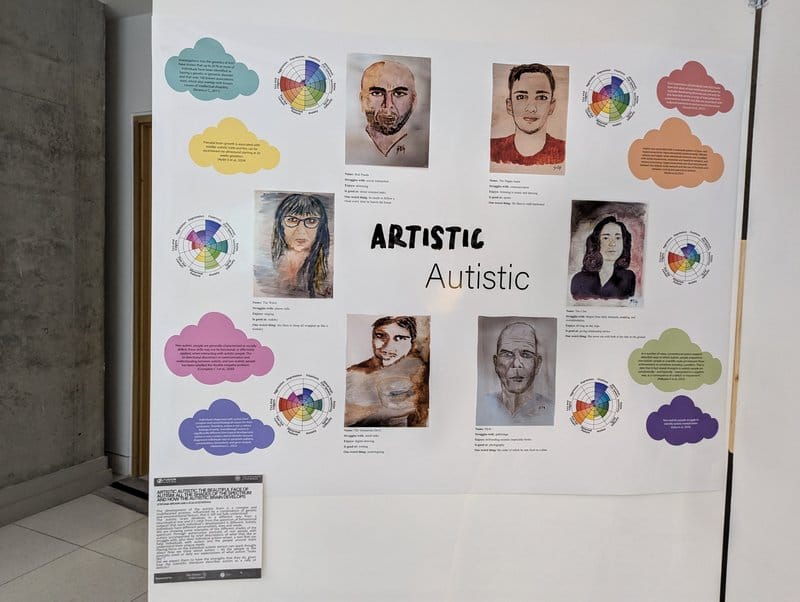
The development of the autistic brain is a complex and multifaceted process, influenced by a combination of genetic and environmental factors, that is still not fully understood.
The autistic brain develops in a different way from a neurotypical one and it’s clear from the spectrum of behavioural outputs that each individuals’ development is different.
Autistic individuals have different personalities, lives and needs.
We are showing some examples of the different shades of the spectrum through watercolour portraits of real people with autism accompanied by brief descriptions of what they like or struggle with, plus their individual autism wheel, a tool that can help individuals with autism and the people around them understand their unique needs.
Placing focus on the individual autistic person can spark thought about how we think about autism – do the people in the portraits meet or defy our expectations of what autism “looks like”?
Did we expect them to have the strengths that they do, given how the scientific literature describes autism as a rally of deficits?
Dora Zoi, David Price
Mindscaping
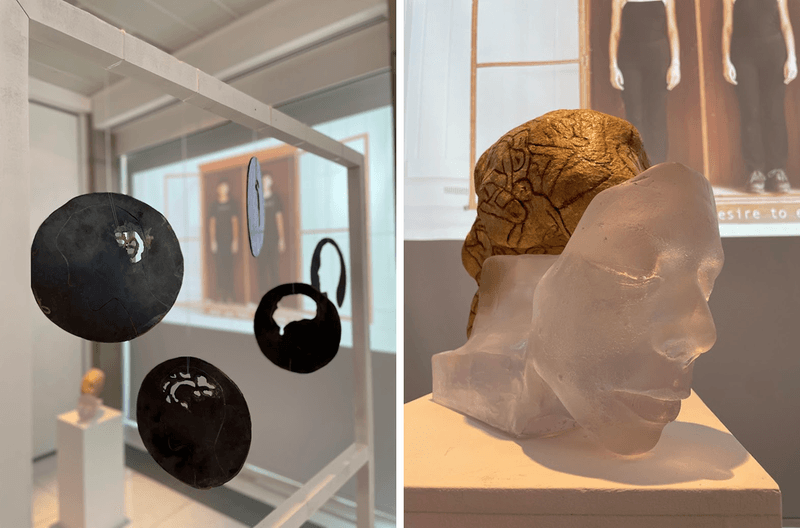
Drawing inspiration from the intricate forms and connections within the human brain, Dora creates sculptural works that capture its physicality and complexity. Her pieces blend scientific insight with artistic expression, welcoming viewers to discover the intriguing dimensions of mental landscapes. By presenting alternative narratives and novel perspectives, the project juxtaposes the discredited practices of 19th-century phrenology with the transformative insights of modern brain science. This installation serves as an enlightening portal, demystifying the flawed notions of phrenologists and showcasing the dynamic, ever-evolving landscape of neuroscience. Emphasizing neural plasticity, the work conveys the empowering message that we can reshape our thoughts and emotions. Dora’s video work highlights the beauty of rare emotional words found on phrenological busts and encourages viewers to deconstruct and recategorize their experiences, fostering a deeper connection to their consciousness. This art installation invites contemplation on the wonders of human cognition and promotes a deeper understanding and appreciation of the mind’s intricacies.
Jackie Bell, Cristina Martinez Gonzalez
…wider than the sky…
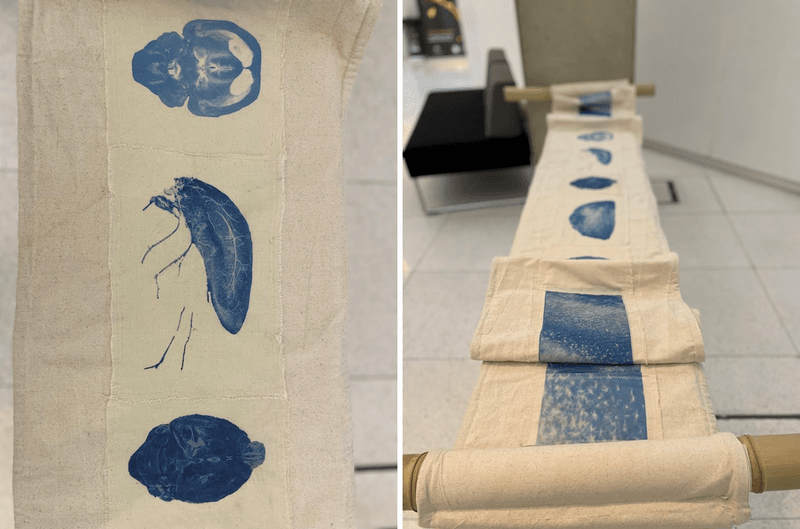
This line from Emily Dickenson’s poem, “The brain is wider than the sky” alludes to the incredible ability of the human brain to encompass all that lies before it.
This artwork has a starting point in Cristina Martinez Gonzalez’s research imaging the mouse brain using light sheet microscopy. The representations give us an insight into the beautiful complexity we share, as Burns would have it, as the mouse’s “poor, earth-born companion an’ fellow-mortal”.
The work uses the form of the scroll, one of the most ancient forms of recording information. It references the Japanese “emaki” form in which the images can be unfurled and viewed individually or sequentially but can also be displayed as a hanging, or more sculpturally draped to evoke the folding of brain structures.
Epilepsy Scotland Youth Group (Collaborators: Emily Beaney, Richard Chin, Martyn Pickersgill and Jeni Haren, with thanks to Kirstyn Cameron, Shelby Johnston, Aimee Lothian)
Doctors and Doner Kebabs
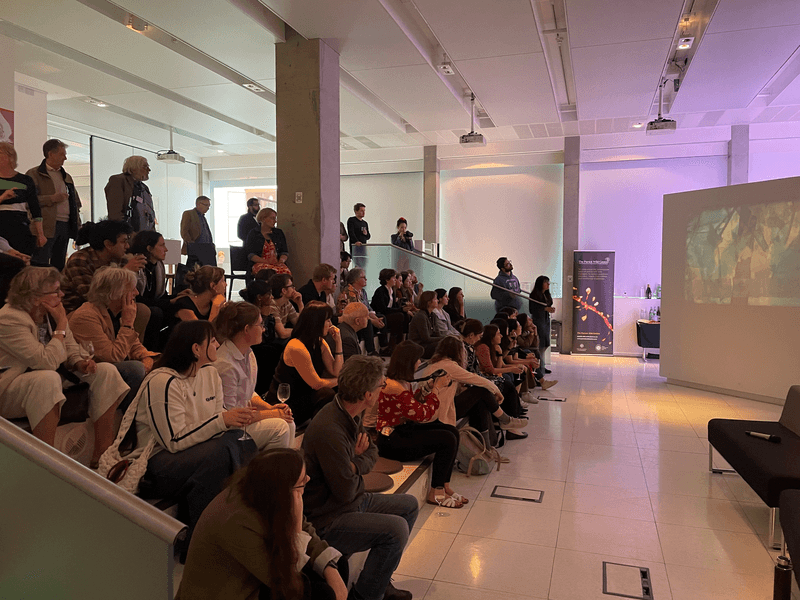
This artwork celebrates individual and collective identities. As one flows into another, our personhood is lost and found. In a series of creative workshops, we explored the ways in which our personalities, preferences, experiences and epilepsies come together and diverge. Here colour, pattern, marks and sound share what holds importance.
Cristina Martinez-Gonzalez, Jackie Bell
Inside my head
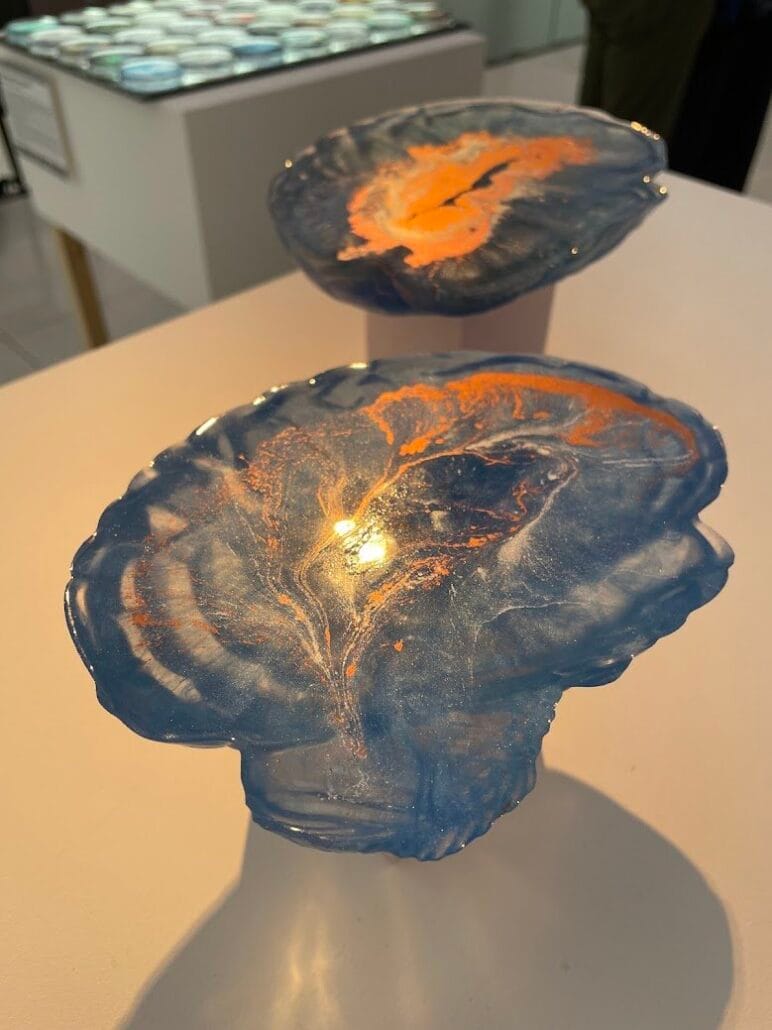
This piece is my interpretation of the disjointed brain. As a dyslexic person, I have developed strategies to overcome the traditional teaching methods at school. Though words and letters may never click with me, 3-dimensional shapes, colours, and images stick to my brain like glue. Thinking differently is a positive attribute in academia, as dyslexia is not a problem with intelligence or vision.
As a neuroscientist, I wanted to represent the colourful dyslexic brain, with unconventional undulating neuronal pathways across distant brain areas, allowing people like me to see the world through different tints. In opposition, the neurotypical brain has canonical neuronal connections and unvaried hues, enabling the correct decoding of sounds and words.
My research combines optical tissue clearing with light-sheet microscopy to investigate rodent models of autism spectrum disorders. In collaboration with Jackie Bell, I created this resin piece to symbolize the “transparent brains” I use to map circuitry variations in neurodevelopmental disorders.
Clara Sánchez-Izquierdo Lozano, Lea Satala
The Lateralised Brain; a myth… with some truth?
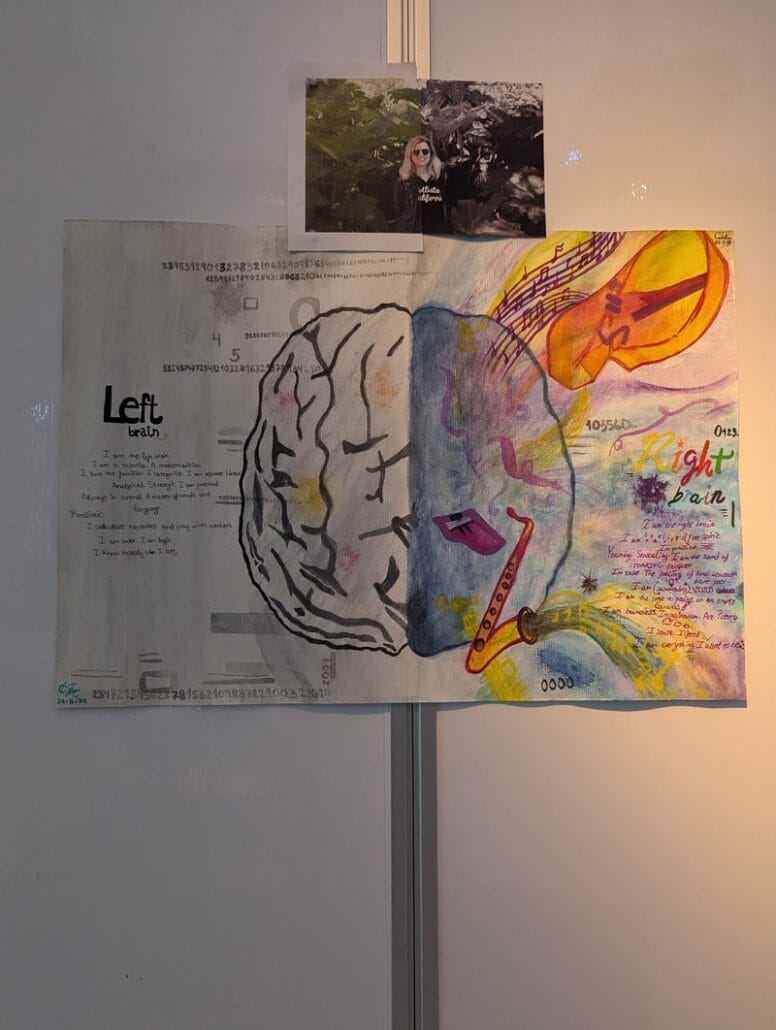
For a long time it was thought that people can be left or right-brained. While that is now a debunked myth as everyone’s brain works as a whole, the idea that the left side of the brain is the logical/analytical and the right side is the creative/emotional does have some truth to it, although it has also been shown that some functions typically belonging to one side of the brain might happen on the other side. With this interactive watercolour and 35mm film piece we intend to artistically shed light into a scientific topic, providing facts visually to speak up about science facts wrongly transformed through the mainstream. The watercolour section initially provides the basic left-brain and right-brain sections, eachwith their typical functions. However, some functions that were discovered to be in the opposite brain side of the one you would initially think (e.g., understanding numbers that contain zeros) have been added. Finally, the 35mm film photographs bring a more ‘humane’ side, as we’re not ‘just’ our brains, but there’s a person for each one, showing brain lateralization in black and white vs. colour, playing with saturation and contrast.
Our brains, as well as our knowledge, is always developing.
Zuzanna Baran, Samiksha Yeole
Bonding Brainwaves: Mapping family connections
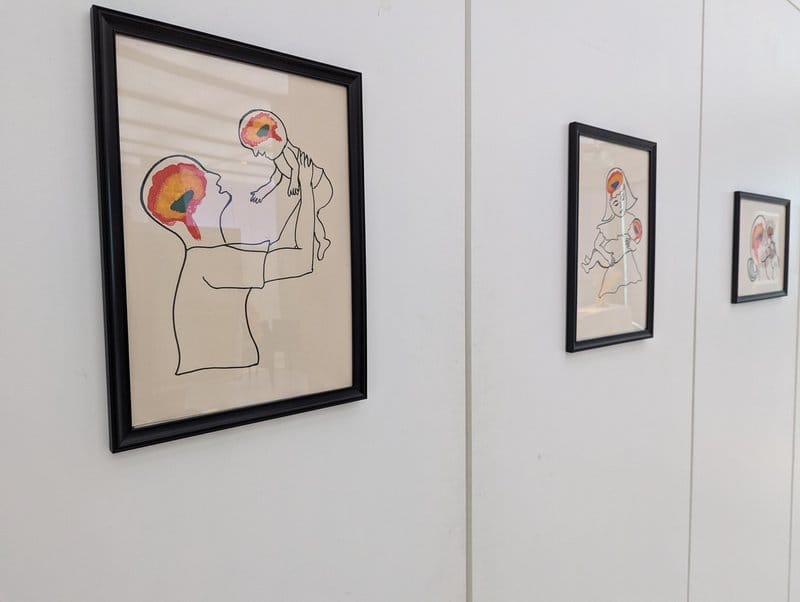
Have you ever wondered how we can recognise our loved ones so quickly in a crowd? How do we develop this uncanny recognition from infancy? Inspired by the groundbreaking research from the Kinship Lab at the University of Edinburgh, where Zuzanna is a PhD student, this artwork explores the enchanting concept of kinship recognition and the intricate mechanisms by which an infant’s brain identifies and bonds with its family members. Imagine a newborn baby surrounded by the comforting touch, sounds and scents of its primary caregivers… This is the beginning of a lifelong foundation of family recognition. Our screen-prints capture these tender moments, using colour to highlight brain regions important for parent-child interactions. From a mother’s gaze to a father’s embrace, each print tells a story of bonding and attachment.
Samiksha created a series that shows the bonding mechanisms at play for parents and siblings, bringing to life the unseen magic of our brain’s capabilities. These screenprints illuminate the brain activity that sparks when a baby interacts with and gazes at the most important people in their young lives. By merging science and art, we invite viewers into the fascinating world of the developing brain. It celebrates the profound significance of family bonds and the neural circuits that sustain them, highlighting the wonder of how our brains help us find familiarity
and solace in those closest to us. This artwork not only tells a story but also ignites curiosity about the marvels of the developing brain, leaving viewers with a deeper appreciation for the ties that bind us.
Gintare Bagacionkaite, Barbora Skarabela, Melissa Thye
No two brains are alike: Celebrating individual differences
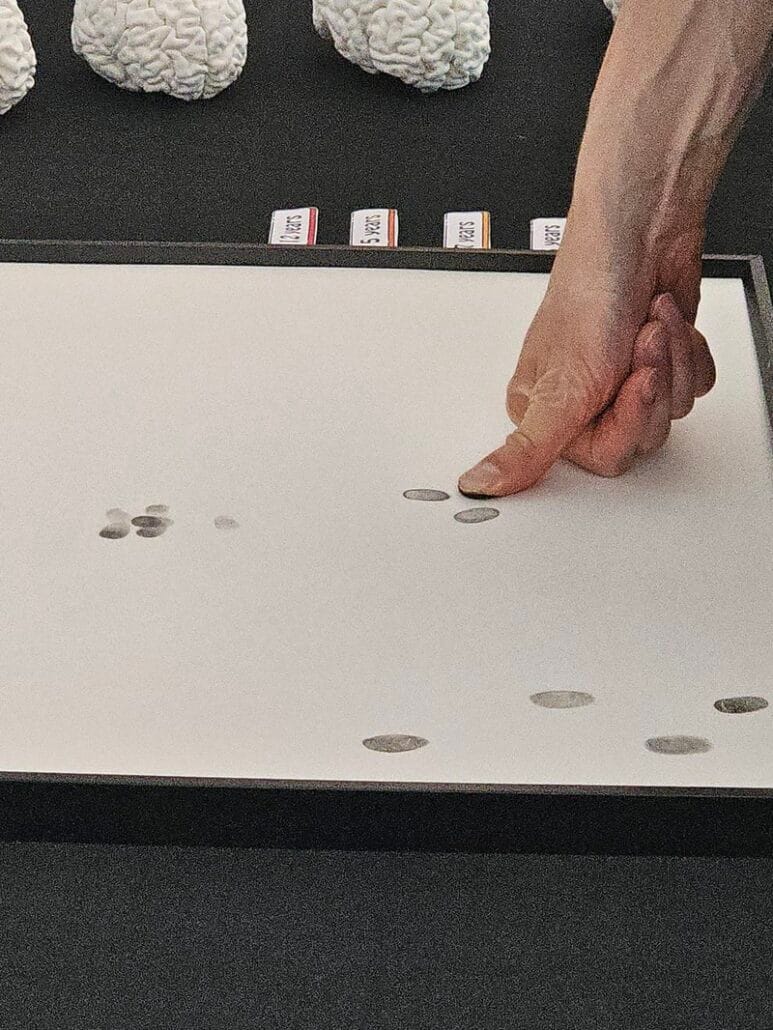
We invite you to contribute your own unique fingerprint to the canvas, turning this blank paper into a living, evolving tapestry of individuality. Each mark left on the canvas serves as a reminder that, just like our fingerprints, no two brains are alike, and our differences are what make us extraordinary.
Annie Campbell, Emma Dumble
Astromortem
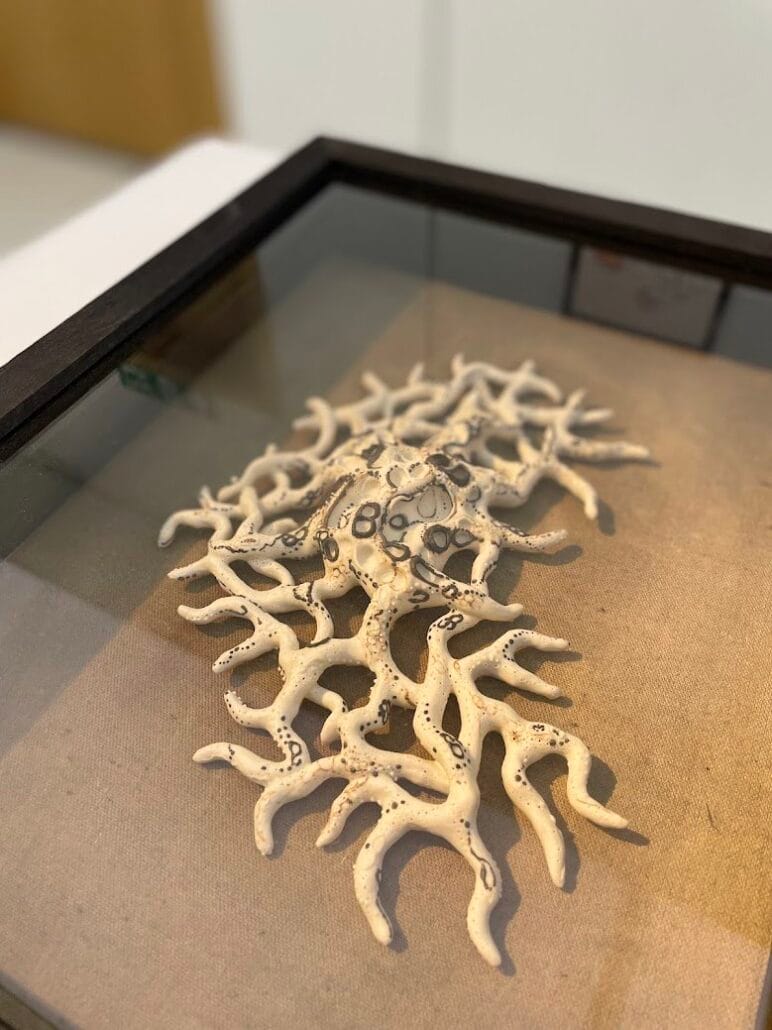
My work examines disconnections between humans and nature in the Anthropocene and society’s artificial constructs that allow us to perceive ourselves as separate from the natural environment. Using clay, organic materials, and mixed media, the work speaks to environmental disasters and expresses our collective fragility in the face of climate change. This piece is inspired by the illustrations of the pioneering Spanish neurologist Santiago Ramon y Cajal (b.1852). I draw conceptual inspiration from his drawings of damaged cells and the retinal neural network to create work that addresses climate change and the role of cognitive dissonance in its perpetuation. This piece is modeled after an astrocyte, a glial cell of the brain and spinal column. These cells are a meaningful symbol in my work due to their incredible ability to repair, regulate, balance, and nourish other cells in the body. In my work, which often features damaged and malformed neurons, astrocytes represent reparative resilience amid an impending crisis. The extreme fragility of these forms conceptually links the work to our precarious position in time. The work is successful when viewers come away with a heightened sense of the precipice upon which we waver. To consider ourselves separate from the biosphere we inhabit is a tenuous fallacy perpetuated by those who stand to profit from this collective delusion.
Renata Riha
Riddle of the Sphinx – Sleep
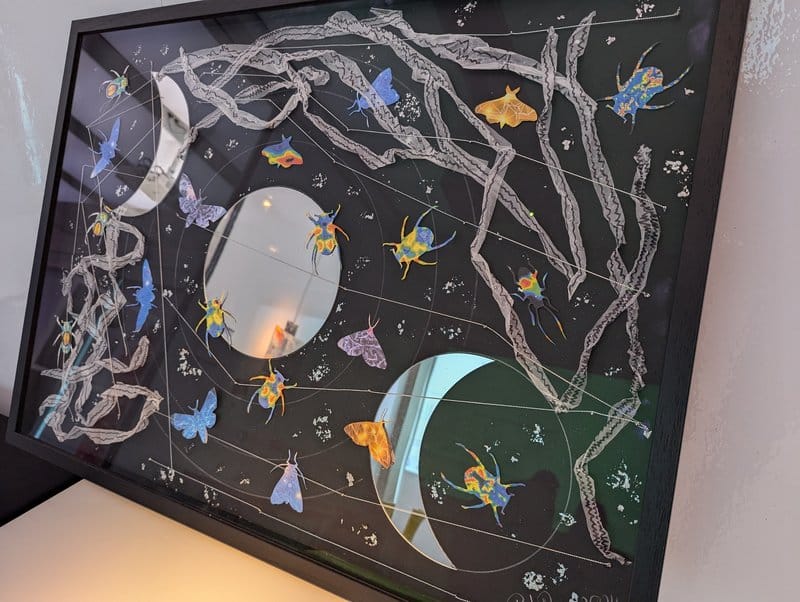
This is a mixed media collage work focussing on how sleep develops from the newborn through adulthood to old age.
Wushuang Tong, David Price
Neuraplysia

“Neuraplysia” is a sculpture named after “Neuro,” symbolizing the brain and nervous system, and inspired by the shape of Aplysia (commonly known as sea hares), a marine mollusk renowned in neuroscience for its large and accessible neural structures. The surface of “Neuraplysia” is adorned with vibrant, interconnected patterns reminiscent of neurons and their synapses. These patterns symbolize the communication and signal transmission between neurons, mirroring the intricate network within the human brain. The shimmering, luminescent elements embedded in the design highlight the nuclei of neurons. The friendly shape of sea hares also creates an inviting atmosphere that welcomes viewers to touch, hug, and explore its surface, much like scientists explore the mysteries of the brain.
My Life Project
Sarah Morris
Syngap 1 – so many symptoms, so many drugs
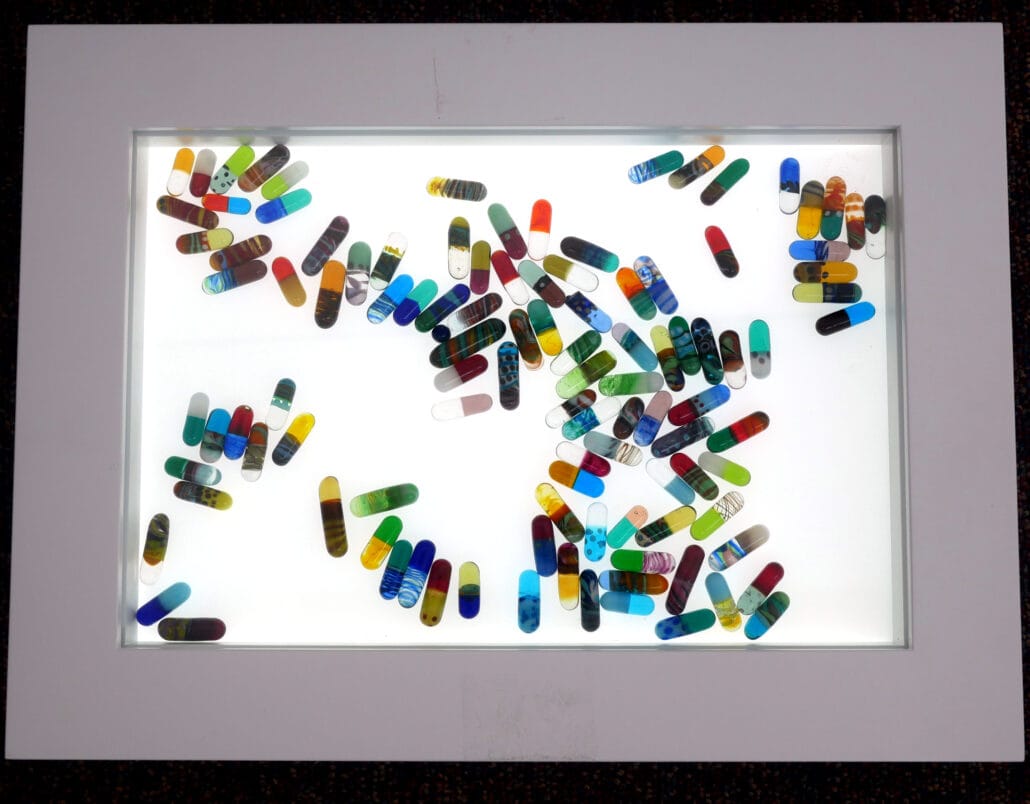
It’s frightening, not knowing how our child will react to the medications which attempt to ameliorate the many symptoms of Syngap1 related disorder. How will we know if he is experiencing one of the plethora of horrible side effects listed? Will it help? Will it be a miracle? Will it harm him? This is a constant feature of our lives. We wait and hope for an ultimate magic bullet. A drug that will treat the underlying cause of the disorder, and lead to a better quality of life for our child.
Will Morris
My brother Sonny
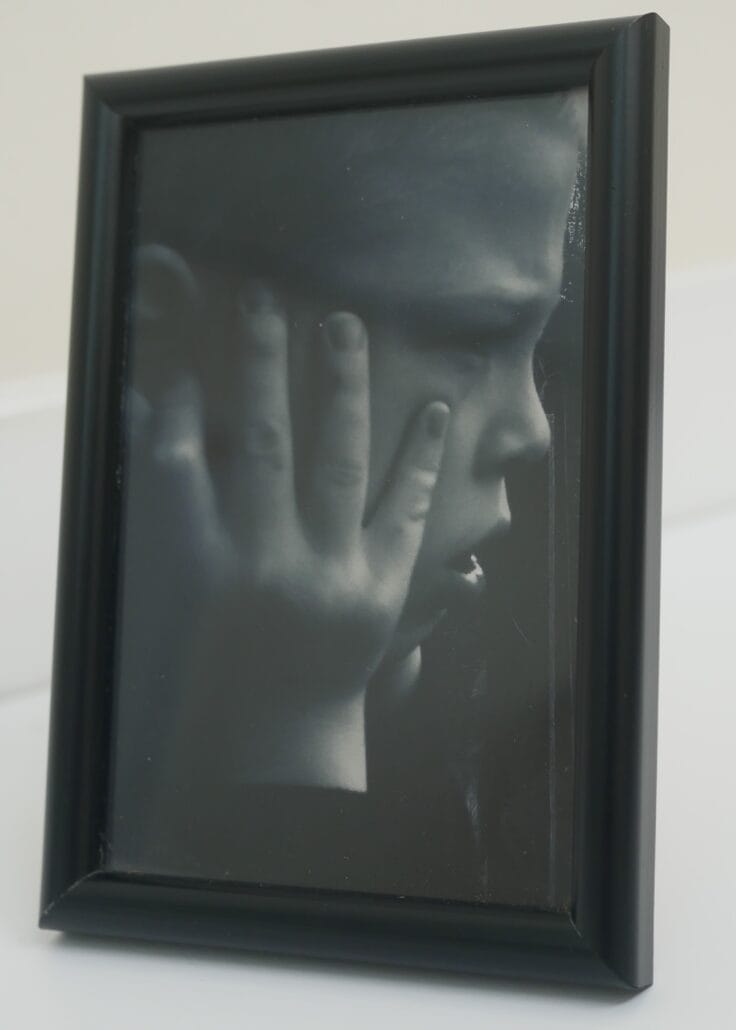
Sonny struggles with being overwhelmed by sensory input, and therefore by default he will often resolve this issue by covering his ears and lowering these senses to a manageable level; as if controlling volume with a button. I took this photo at an animal park while he was looking at pigs, and I love how it shows that he can be peaceful despite the challenges he faces. A restful and undisturbed moment.
Freddie James
Fragile X emotions on Faces
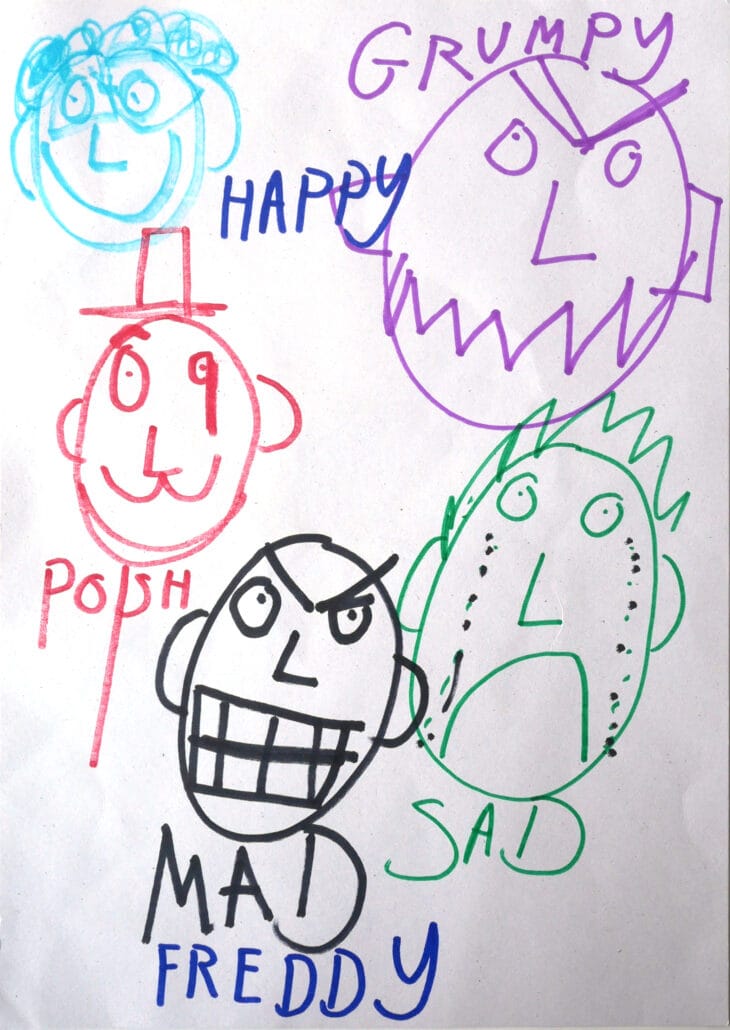
Freddy cannot always express how he feels but he has drawn some of the emotions he does understand.
Tom Pratt
Life Story
The name ‘Life Story’ comes from a 1987 BBC2 drama about the discovery of the structure of DNA . This work was suggested by a model of the DNA double helix displayed in the National Museum of Scotland allegedly made for Francis Crick when he visited Edinburgh to give a
lecture. As a molecular biologist DNA is often on my mind and as a parent I love making things with my children, this is one of those.
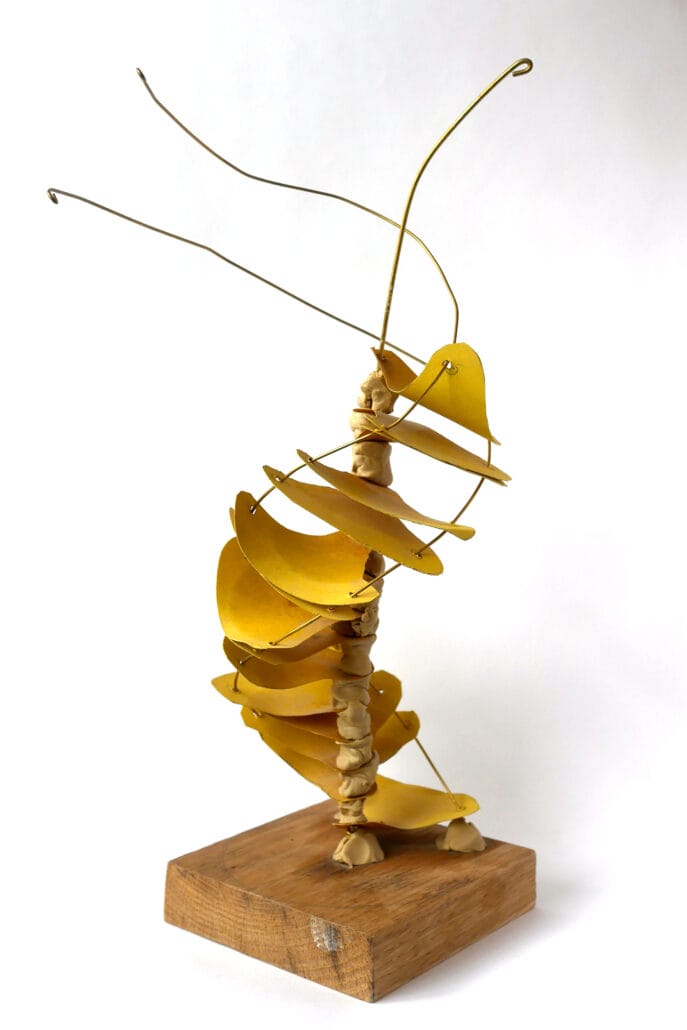
Andrew Stanfield, Priorities
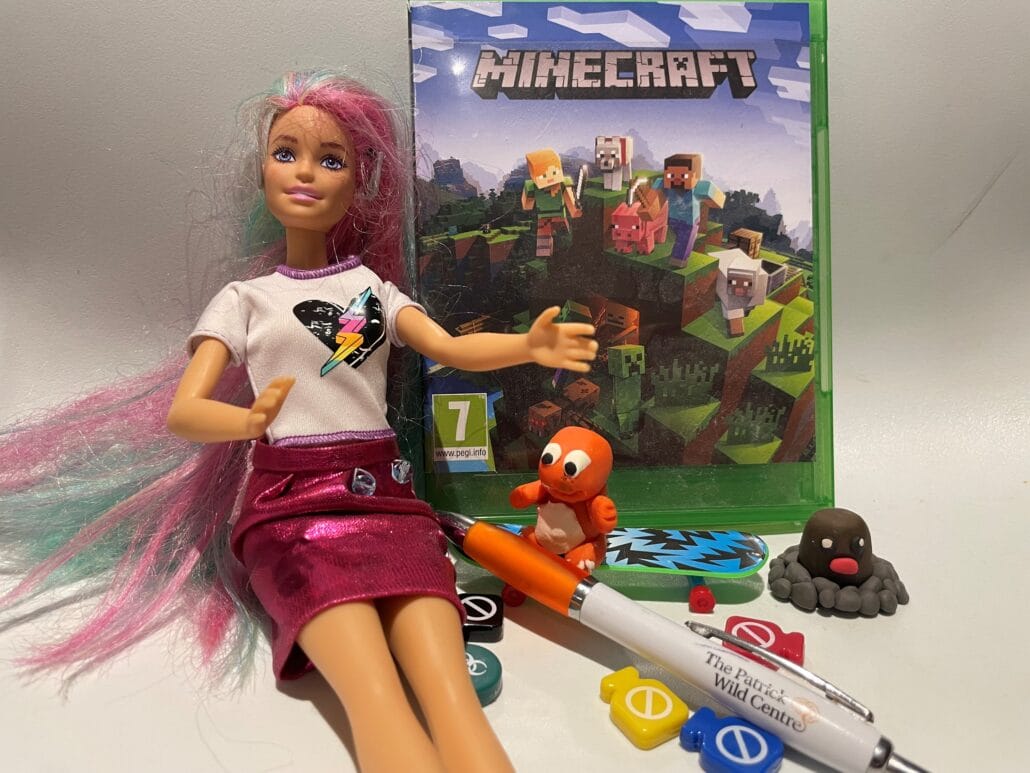
Zoe McGonigle, Adventure in the Land of Pigeons
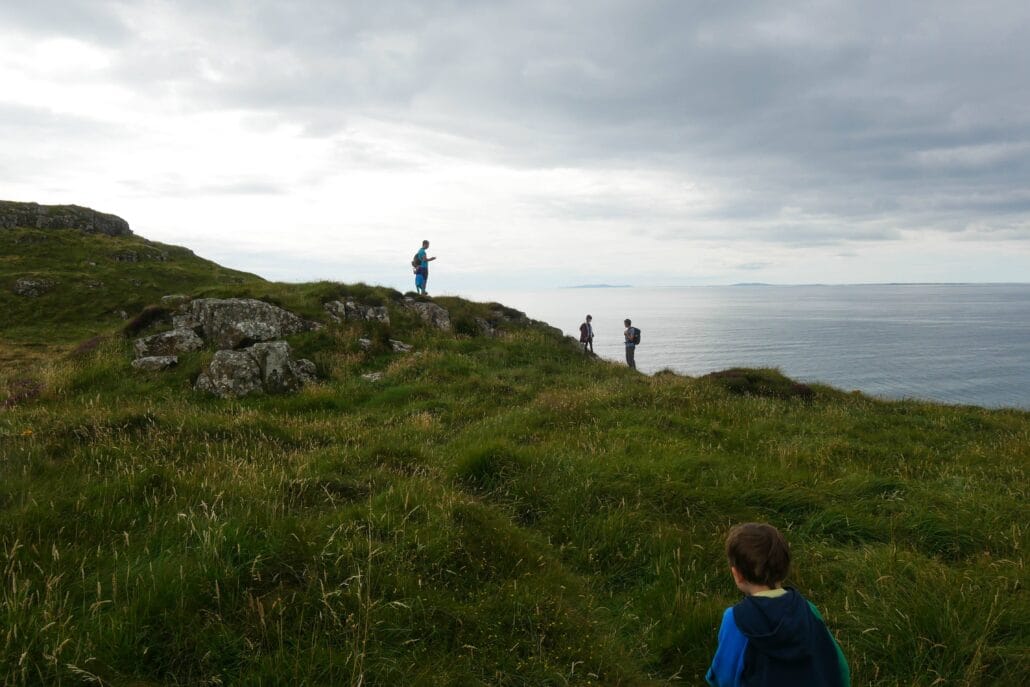
Sarah Eley, My family and I
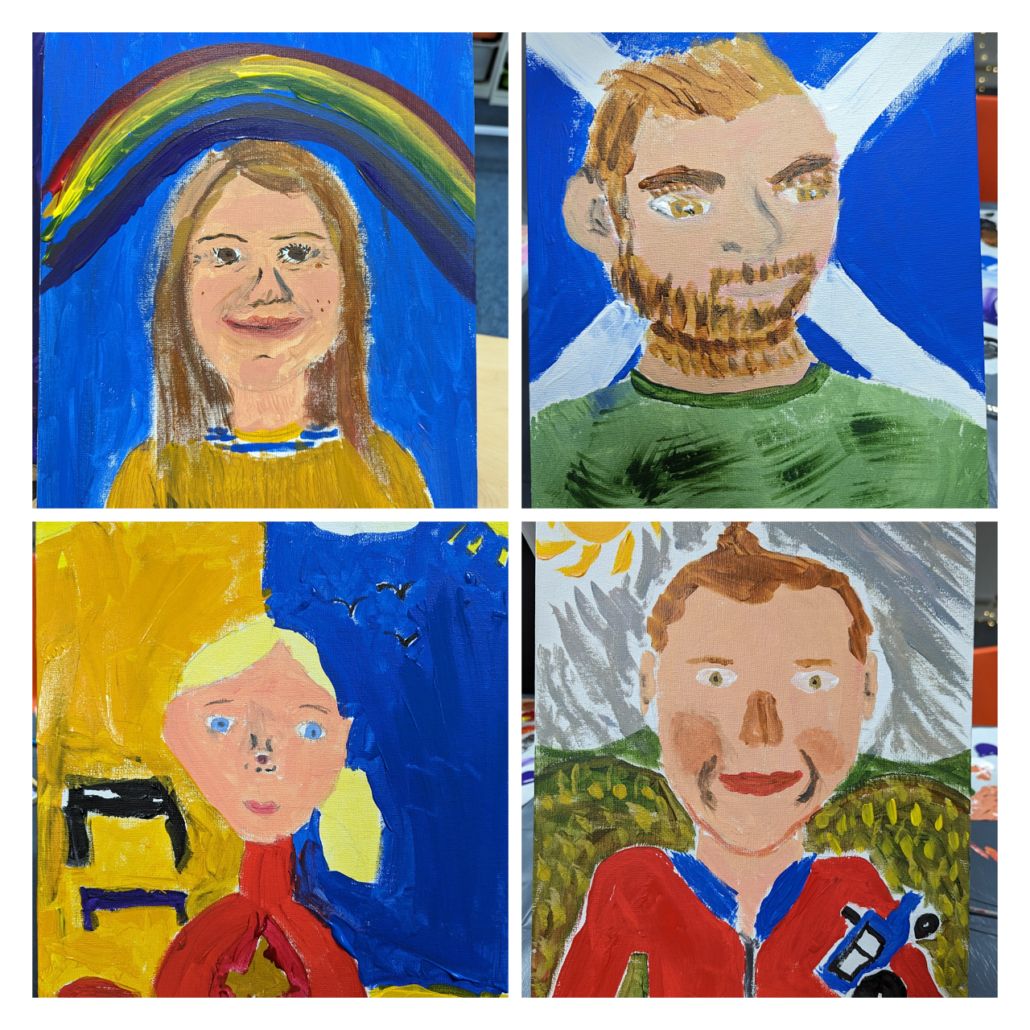
My family, drawn by family members including what they feel represents them in the background.
